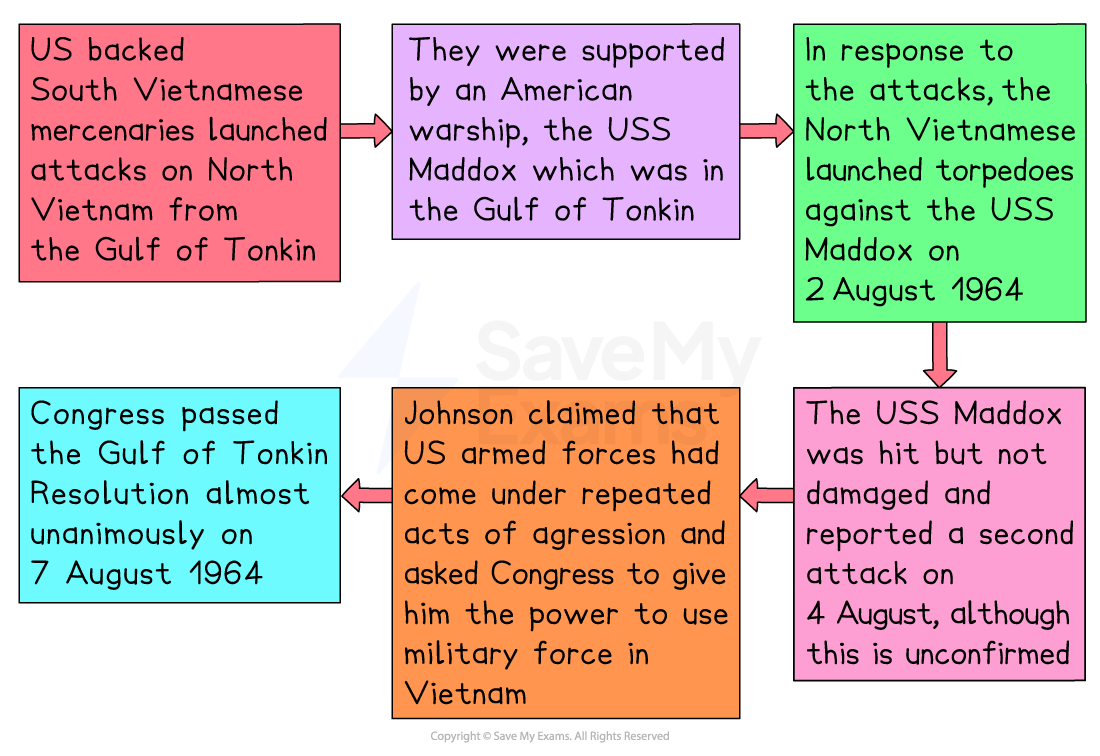How Did President Johnson Escalate the War? (AQA GCSE History): Revision Note
Exam code: 8145
President Johnson and the Vietnam War - Summary
The USA never officially declared war on North Vietnam, but an attack on a US Navy ship in the Gulf of Tonkin led to it becoming directly involved in the conflict. The Gulf of Tonkin Resolution gave President Johnson permission to use all aspects of the USA’s huge military to protect South Vietnam.
The US military adopted search and destroy tactics to find and kill the Vietcong and poisoned enormous areas of the jungle to remove their hiding places. It also launched an enormous aerial bombing campaign called Operation Rolling Thunder.
None of the new tactics were effective enough to lead to victory for the USA. Instead, they often increased support for the Vietcong, which remained in control of large areas of the countryside.

Gulf of Tonkin incident
The Gulf of Tonkin Incident was the key event that led to US troops fighting in Vietnam
It occurred in August 1964, when the US president was Lyndon Baines Johnson
Like Eisenhower and Kennedy before him, Johnson believed in the Domino Theory
Johnson also seemed reluctant to send American troops to Vietnam
All that changed after the Gulf of Tonkin incident
A US warship, USS Maddox, was torpedoed while supporting attacks on North Vietnam
The warship was hit but no major damage was done
The event was enough to persuade Congress of aggression from North Korea
The Gulf of Tonkin Resolution meant that President Johnson was free to use the US military to defend South Vietnam — and attack North Vietnam — in whichever way he chose

US response to Vietcong tactics
Like the French troops and Diem’s ARVN before them, the US soldiers struggled against the Vietcong’s guerrilla tactics
By operating in small groups and by not wearing uniforms, it was almost impossible for the Americans to tell who was a Vietcong fighter and who was a farmer
By patrolling through the jungle to find the Vietcong, US troops exposed themselves to booby traps and ambushes
US troops were being killed, but the Vietcong were not being found, let alone killed
In response, the US adopted search and destroy tactics
It built fortified bases all across South Vietnam from where it could launch search and destroy missions
Travelling by helicopter, troops would suddenly descend on villages and search for evidence of the Vietcong
If they found Vietcong fighters, they would call for backup and order airstrikes
If they found weapons or foodstores, they would burn down the villages

Search and destroy tactics were not successful
US troops were still killed by booby traps and ambushes when they left their helicopters
It led to an increase in support for the Vietcong as villagers resented having their homes destroyed
The Vietcong continued to escape the searches and would disappear into the jungle or across borders to foreign countries such as Laos and Cambodia
The Vietcong usually moved back and took control of an area once the US helicopters had left
To prevent the Vietcong from hiding in the dense jungle, the US launched Operation Ranch Hand from 1962 until 1971
This involved spraying millions of litres of herbicide or defoliant to kill the plants
This was intended to expose Vietcong trails and bases and destroy their food
Exposure to these chemicals led to birth defects for many years after the war had ended

Operation Rolling Thunder
To cut off the Vietcong’s supplies, the US military targeted the supply routes and North Vietnam’s cities and factories with a sustained aerial bombing campaign called Operation Rolling Thunder
It began in March 1965 and continued until November 1968
During that time, nearly 900,000 tons of bombs were dropped on Vietnam
It is estimated that around 90,000 people were killed
Despite the enormous scale of the bombing, Operation Rolling Thunder was not as successful as the US hoped
The Ho Chi Minh Trail was often just a dirt track and was easily repaired
The Vietcong built extensive underground bases and tunnel complexes that protected them from the bombing
It failed to break the resolve of the Vietcong or the North Vietnamese
Fear of bringing China directly into the conflict stopped the US from bombing North Vietnam’s ports
This meant that supplies, including jet fighters and air defence systems, continued to arrive in North Vietnam
Over 3,000 American war planes were shot down during the Vietnam War

Examiner Tips and Tricks
You will be asked to write a narrative account in this paper. This does not mean you have to describe what happened — you have to explain why something happened and what this led to. This means thinking about cause and consequence.

Unlock more, it's free!
Did this page help you?